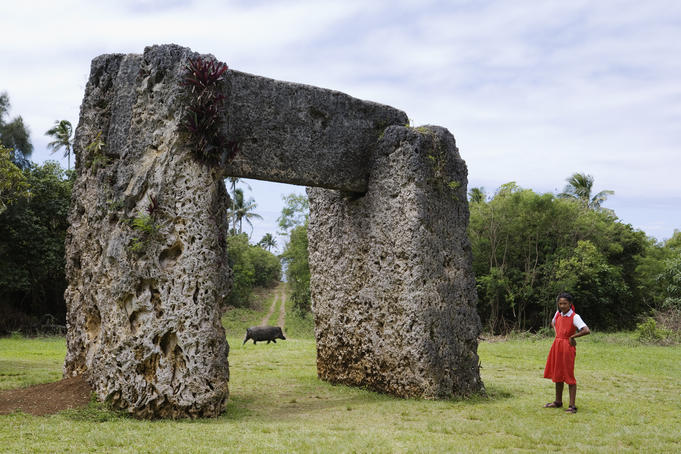
Another trilithon--this time from Tonga in the South Pacific where one finds all sorts of bizarre things from mysterious pyramids to the Easter Island heads. The trilithon in eastern Tongatapu Island in Tonga called
Ha'amonga 'a Maui or “Maui’s Burden” as it represents the great hero, Maui, holding up the heavens. The Wikipedia article on this structure is laughably skeptical and poorly researched saying, for example, that the structure is composed of limestone and weighs 12 tons. The structure is composed three slabs of coral weighing 20 tons each! The slabs were quarried from Wallis Island and brought to Tongatapu. A Wiki article states that the trilithon served as nothing more than the entrance to the court of the 13th century King Tu’i Tonga Tu’itatui and that claims of it having astronomical significance are bogus. According the website run by the Tongan monarchy, the trilithon is, in fact, a sundial. The Wiki article states that this claim was advanced in 1967 as a way of rivaling Stonehenge. The article also states that Stonehenge’s astronomical alignments “are now largely believed to have been overhyped.” In fact, Stonehenge has been proven to be a neolithic observatory. (This was several years ago and I've not been to the Wiki site since so that info may have changed by now) The Tongan monarchy website states:
The sun is extremely significant in Tongan culture, in terms of seasonal periods, measured over years, months and days. The suns duration is measured from sunrise to sunset and seasonal months were divided between sowing, planting and reaping seeds, each dependent on the earth’s rotation. Everyday activities in Tonga are also dependent on the sun, including: fishing, canoe sailing, marriages and construction.
The shortest day in Tonga occurs when the sun is exactly 23 ½ degrees (Tropic of Cancer). When the sun is on the equator, it is moving toward the southern hemisphere and conversely, the northern hemisphere is moving towards the winter. When the sun is on the Tropic of Capricorn, more light is shed in Tonga than darkness. All the three sun markers are indicative of the seasonal changes that occur in Tonga in accordance with the rising of the sun, which is exactly in line with the W etching found on the top slab of the Ha'amonga 'a Maui.
The importance of the Latitude and Longitude of the Ha'amonga 'a Maui is that the coral slabs when constructed on land and are in a position that is high enough to observe the sea horizon when during sunrise. Investigations revealed that not only are the height of the coral slabs scientifically calculated towards the sea, but they are also true magnetic north.
The Ha'amonga 'a Maui has been scientifically interpreted as an early style sundial clock that recorded different seasonal changes. The Ha'amonga 'a Maui fully acknowledges the sea position of Tongatapu and the exact observation of the morning sunrise on the shortest, midway and longest day. How our ancestors knew the science of the sun's positional sunrise along the Tropic of Cancer, Equator and Capricorn remains a mystery.
As a result of the research, the success of the Tongan Maritime Empire has been directly related to the Ha'amonga 'a Maui. The trilithon enabled Tongan leaders to understand the astronomy of the sky, sun routes and was used as a seasonal calendar.
Pshaw! Those silly, superstitious non-Caucasians!